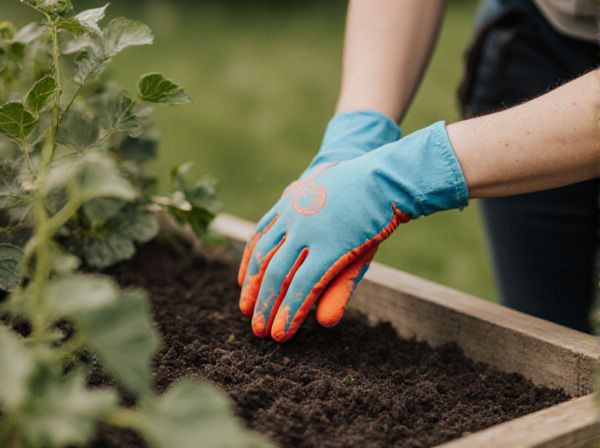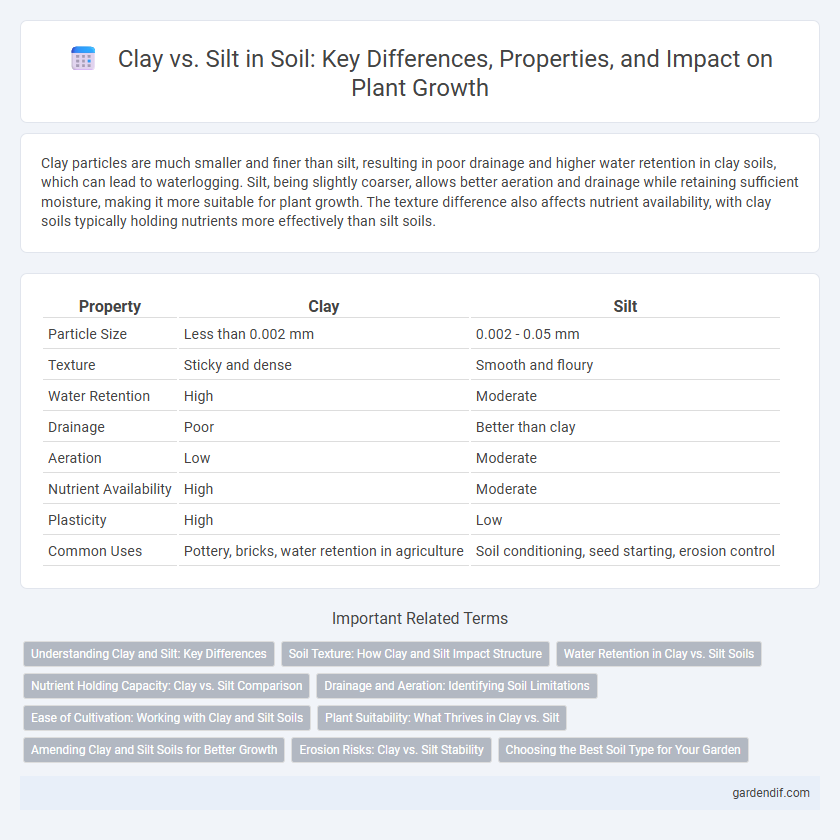
Clay vs Silt Illustration
Clay particles are much smaller and finer than silt, resulting in poor drainage and higher water retention in clay soils, which can lead to waterlogging. Silt, being slightly coarser, allows better aeration and drainage while retaining sufficient moisture, making it more suitable for plant growth. The texture difference also affects nutrient availability, with clay soils typically holding nutrients more effectively than silt soils.
Table of Comparison
| Property | Clay | Silt |
|---|---|---|
| Particle Size | Less than 0.002 mm | 0.002 - 0.05 mm |
| Texture | Sticky and dense | Smooth and floury |
| Water Retention | High | Moderate |
| Drainage | Poor | Better than clay |
| Aeration | Low | Moderate |
| Nutrient Availability | High | Moderate |
| Plasticity | High | Low |
| Common Uses | Pottery, bricks, water retention in agriculture | Soil conditioning, seed starting, erosion control |
Understanding Clay and Silt: Key Differences
Clay particles are smaller than silt, typically less than 0.002 mm in diameter, resulting in higher plasticity and water retention. Silt particles range between 0.002 mm and 0.05 mm, offering better drainage and aeration compared to clay. Understanding the differences in particle size and behavior is crucial for soil management and agricultural productivity.
Soil Texture: How Clay and Silt Impact Structure
Clay particles are the smallest soil components, typically less than 0.002 mm in diameter, giving clay-rich soils a dense texture with high water retention and low permeability. Silt particles, ranging from 0.002 to 0.05 mm, create a smoother texture that enhances soil aeration and drainage compared to clay but retains more moisture than sand. The balance between clay and silt influences soil structure by affecting porosity, nutrient availability, and susceptibility to erosion, which are critical factors for plant growth and soil management.
Water Retention in Clay vs. Silt Soils
Clay soils have significantly higher water retention compared to silt soils due to their smaller particle size and greater surface area, which allows them to hold more water molecules tightly. Silt soils, with their medium-sized particles, drain faster and retain less water, making them less effective at sustaining moisture under dry conditions. The high water retention of clay can lead to waterlogging, whereas silt balances moisture retention and drainage more efficiently.
Nutrient Holding Capacity: Clay vs. Silt Comparison
Clay particles have a higher cation exchange capacity (CEC), enabling them to retain more nutrients such as potassium, calcium, and magnesium compared to silt. This nutrient holding capacity makes clay-rich soils more fertile and better at supplying essential minerals to plants over time. In contrast, silt particles, being larger and less charged, hold fewer nutrients and exhibit lower CEC, resulting in quicker nutrient leaching and reduced fertility.
Drainage and Aeration: Identifying Soil Limitations
Clay soils exhibit poor drainage and reduced aeration due to their fine particle size, resulting in water retention and limited oxygen availability for roots. In contrast, silt soils possess moderate drainage and better aeration, balancing moisture retention with airflow to support healthy root growth. Understanding these differences is crucial for managing soil limitations in agricultural and landscaping applications.
Ease of Cultivation: Working with Clay and Silt Soils
Clay soils have fine particles that retain moisture and nutrients well, making them fertile but often heavy and compact, which can make cultivation labor-intensive and slow. Silt soils, with their smooth texture and moderate nutrient content, are generally easier to till and cultivate, requiring less effort to break up and maintain. Proper management of clay soils, such as adding organic matter, improves aeration and drainage, whereas silt soils benefit from erosion control to maintain their structure and fertility.
Plant Suitability: What Thrives in Clay vs. Silt
Clay soils retain water and nutrients effectively, making them ideal for plants like rice, iris, and willow trees that thrive in moisture-rich environments. Silt soils offer better drainage and aeration, supporting crops such as lettuce, beans, and most vegetables that require moderate moisture and nutrient levels. Understanding the moisture retention and texture differences between clay and silt is essential for optimizing plant growth and health.
Amending Clay and Silt Soils for Better Growth
Amending clay soils involves incorporating organic matter such as compost or aged manure to improve drainage and aeration while reducing compaction. For silt soils, adding coarse sand or organic material enhances structure and prevents nutrient leaching, promoting optimal root development. Both soil types benefit from regular mulching and avoiding overwatering to maintain balanced moisture and nutrient levels for better plant growth.
Erosion Risks: Clay vs. Silt Stability
Clay particles, being finer and more cohesive, typically exhibit higher resistance to erosion compared to silt, which is composed of slightly larger, less cohesive particles prone to detachment by water and wind. The stability of clay soils reduces sediment transport and minimizes surface runoff, while silt soils are more susceptible to erosion due to weaker particle bonding and higher permeability. Understanding these differences is critical for effective soil conservation and land management practices in erosion-prone areas.
Choosing the Best Soil Type for Your Garden
Clay soil offers excellent nutrient retention and moisture-holding capacity, making it ideal for water-loving plants but prone to poor drainage and compaction. Silt soil provides a smooth texture with good fertility and better drainage than clay, supporting a wide range of garden plants while reducing root rot risks. Selecting the best soil type depends on your plant's water requirements and soil management practices to optimize growth and health.
Clay vs Silt Infographic

 gardendif.com
gardendif.com